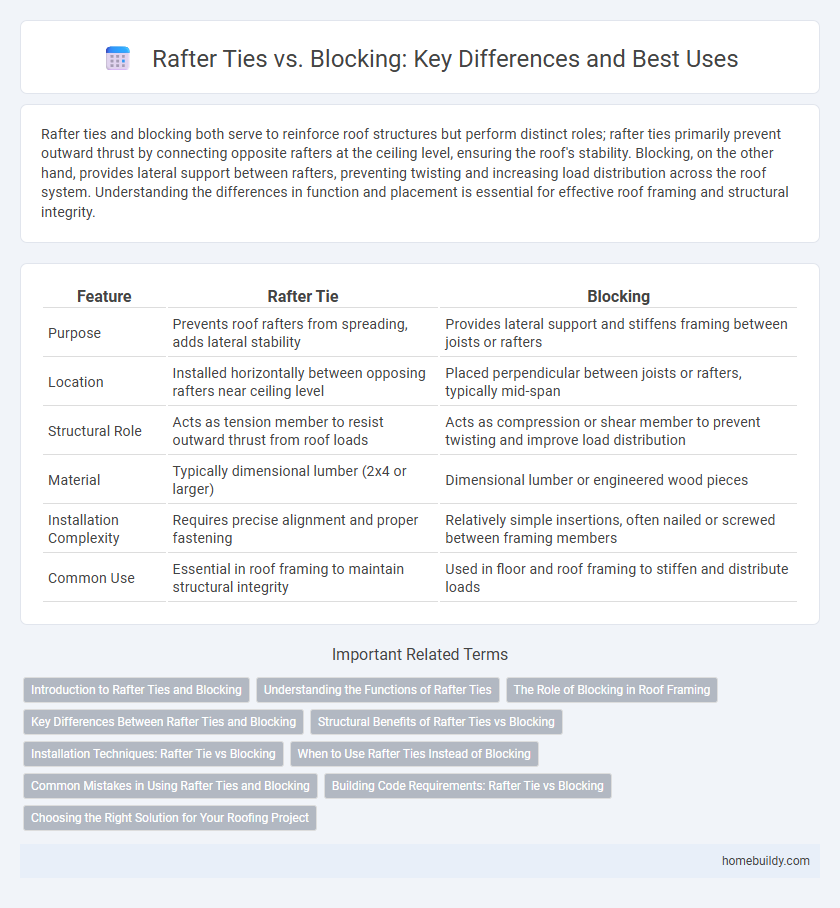Rafter ties and blocking both serve to reinforce roof structures but perform distinct roles; rafter ties primarily prevent outward thrust by connecting opposite rafters at the ceiling level, ensuring the roof's stability. Blocking, on the other hand, provides lateral support between rafters, preventing twisting and increasing load distribution across the roof system. Understanding the differences in function and placement is essential for effective roof framing and structural integrity.
Table of Comparison
| Feature | Rafter Tie | Blocking |
|---|---|---|
| Purpose | Prevents roof rafters from spreading, adds lateral stability | Provides lateral support and stiffens framing between joists or rafters |
| Location | Installed horizontally between opposing rafters near ceiling level | Placed perpendicular between joists or rafters, typically mid-span |
| Structural Role | Acts as tension member to resist outward thrust from roof loads | Acts as compression or shear member to prevent twisting and improve load distribution |
| Material | Typically dimensional lumber (2x4 or larger) | Dimensional lumber or engineered wood pieces |
| Installation Complexity | Requires precise alignment and proper fastening | Relatively simple insertions, often nailed or screwed between framing members |
| Common Use | Essential in roof framing to maintain structural integrity | Used in floor and roof framing to stiffen and distribute loads |
Introduction to Rafter Ties and Blocking
Rafter ties and blocking are critical components in roof framing that enhance structural stability by preventing walls from spreading under roof loads. Rafter ties are horizontal members placed between opposing rafters to resist outward thrust, while blocking consists of short pieces of wood installed between rafters to provide lateral support and prevent twisting. Understanding the differences between rafter ties and blocking is essential for ensuring proper roof load distribution and maintaining overall building integrity.
Understanding the Functions of Rafter Ties
Rafter ties serve a crucial role in preventing the outward spread of rafters and maintaining the structural integrity of a roof by connecting opposite rafters at lower points. Unlike blocking, which provides lateral support within the framing and resists twisting or buckling, rafter ties primarily counteract outward thrust forces. Understanding that rafter ties act as tension members helps ensure proper roof load distribution and prevents wall deformation.
The Role of Blocking in Roof Framing
Blocking in roof framing acts as a crucial stabilizer by preventing rafters from twisting and maintaining proper spacing between them, which enhances structural integrity. Unlike rafter ties that connect opposing rafters at the ceiling level to resist outward thrust, blocking provides lateral support directly between rafters, distributing loads evenly and increasing roof rigidity. Proper installation of blocking ensures the roof framing system remains stable under various loads, reducing the risk of sagging or structural deformation.
Key Differences Between Rafter Ties and Blocking
Rafter ties are horizontal beams installed between opposing rafters to prevent the roof structure from spreading and maintain stability, while blocking consists of short pieces of wood placed between rafters to provide lateral support and prevent twisting. Rafter ties resist outward thrust, directly supporting roof loads, whereas blocking primarily helps with load distribution and alignment of rafters. Understanding these differences is crucial for proper structural integrity and compliance with building codes.
Structural Benefits of Rafter Ties vs Blocking
Rafter ties provide critical structural reinforcement by preventing roof rafters from spreading and maintaining the integrity of the roof structure under load, effectively resisting outward thrust forces. Blocking, while useful for lateral support and stabilizing framing members, does not prevent rafter spread and primarily serves to brace and stiffen the assembly rather than enhance overall roof tie-in strength. The use of rafter ties is essential for maintaining roof stability in high wind or heavy snow conditions, offering superior load distribution compared to blocking alone.
Installation Techniques: Rafter Tie vs Blocking
Rafter ties are installed by fastening horizontal beams between opposing rafters near the roof's base to prevent outward thrust and maintain structural integrity. Blocking involves inserting short pieces of lumber perpendicular between rafters to provide lateral support and restrict twisting. While rafter ties are typically nailed or screwed directly to the rafters, blocking requires precise spacing and alignment for effective load distribution.
When to Use Rafter Ties Instead of Blocking
Rafter ties are essential in roof framing when preventing the outward spread of rafters, especially in open ceiling designs where ceiling joists or blocking are absent or insufficient. Use rafter ties to resist outward thrust and maintain roof stability in spans without intermediate support, particularly in attic spaces that remain unfinished or accessible. Blocking is more appropriate for distributing loads and providing lateral support between rafters, but rafter ties are critical when tensile reinforcement is required to keep rafters from separating.
Common Mistakes in Using Rafter Ties and Blocking
Common mistakes in using rafter ties and blocking include confusing their purposes, where rafter ties prevent outward wall spread while blocking primarily adds structural support between rafters. Incorrect placement of rafter ties too high on the rafters reduces their effectiveness in resisting outward thrust. Blocking is often misused as a substitute for rafter ties, which can compromise roof stability and lead to structural failure.
Building Code Requirements: Rafter Tie vs Blocking
Building codes specify distinct requirements for rafter ties and blocking due to their differing structural functions. Rafter ties are mandated to resist outward thrust and prevent roof spreading by securing opposing rafters, often requiring specific dimensions and fastening methods per code. Blocking primarily serves to stabilize and brace rafters against lateral movement, and building codes prescribe exact spacing and size criteria to ensure proper load distribution and roof integrity.
Choosing the Right Solution for Your Roofing Project
Rafter ties and blocking serve distinct structural purposes in roofing projects, with rafter ties primarily preventing outward wall spread and maintaining roof stability. Blocking, typically installed between rafters, provides lateral support and helps distribute loads evenly. Selecting the right solution depends on roof design, load requirements, and local building codes to ensure optimal structural integrity and safety.
Rafter tie vs Blocking Infographic

 homebuildy.com
homebuildy.com